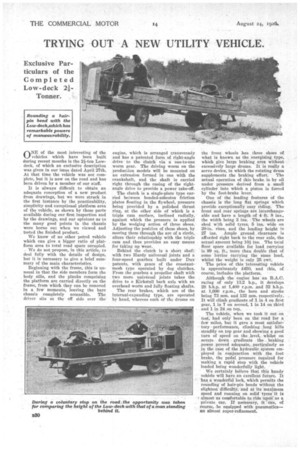TRYING OUT A NEW UTILITY VEHICLE.
Page 48

If you've noticed an error in this article please click here to report it so we can fix it.
ONE of the most interesting of the vehicles which have been built during recent months is the 2i-ton Low deck, of which an exclusive description was given in our issue dated April 27th. At that time the vehicle was not complete, but it is now on the road and has been driven by a member of our staff.
It is always difficult to obtain an adequate conception of a new product from drawings, but we were struck in the first instance by the practicability, simplicity and exceptional platform area of the vehicle, as shown by those parts available during our first inspection and by the drawings, and our opinions as to the many good points in the chassis were borne out when we viewed and tested the finished product.
We know of no other petrol vehicle which can give a bigger ratio of platform area to total road space occupied. -We do not propose, in this article, to deal fully with the details of design, but it is necessary to give a brief summary of the main characteristics.
Beginning with the frame, this is unnsual in that the side members form the body sills, and the planks comprising the platform are carried directly on the frame, from which they can be removed in a few moments, leaving the bare chassis completely accessible. The driver sits at the• oft side over the engine, which is arranged transversely and has a patented form of right-angle drive to the clutch via a one-to-one worm gear. The driving worm on the production models will be mounted on an extension formed in one with the crankshaft, and the shaft is carried right through the casing of the rightangle drive to provide a power take-off.
The clutch is a single-plate type carried between bonded-asbestos friction plates floating in the flywheel, pressure being provided by a polished thrust ring, at the other side of which is a triple cam surface, inclined radially, against which the pressure is applied by the wedging action of three shoes. Adjusting the position of these shoes, by moving them through the arc of a circle, alters their relationship with the triple cam and thus provides an easy means for taking up wear.
Behind the clutch is a short shaft with two Hardy universal joints and a four-speed gearbox built under Dux patents, with gears of the constantmesh type operated by dog clutches. From the gearbox a propeller shaft with two more universal joints takes the drive to a Kirkstall back axle with an overhead worm and fully floating shafts.
The rear brakes, which are of the internal-expanding type, are operated by hand, whereas each of the drums on the front wheels has three shoes of what is known as the energizing type, which give large braking area without excessively large drums. It is really a servo device, in which the rotating drum supplements the braking effort. The actual operation of this brake is by oil under pressure derived from a small cylinder into which a piston is forced by the foot-brake lever.
One of the leading features of the chassis is the long flat springs which provide exceptionally easy riding. The front and rear springs are interchangeable and have a length of 4 ft. 8 ins., the width being 3 ins. The wheels are shod with solid tyres, 5 ins. wide on 20-in. rims, and the loading height is 27 ins. Ample ground clearance is afforded right back to the rear axle, the actual amount being 1% ins. The total floor space available for load carrying is 99 sq. ft., more than double that of some lorries carrying the same load, whilst the weight is only 25 cwt.
The price of this interesting Vehicle is approximately £450, and this, of course, includes the platform.
• Although the engine has an R.A.C. rating of only 13.2 h.p., it develops
28 b.h.p. at 1,400 r.p.m. and 32 blip. at 1,600 r.p.m., the bore and stroke being 73 mm. and 133 mm. respectively. It will climb gradients of 1 in 4 on first gear, 1 in 7 on second, 1 in 14 on third and 1 in 24 on top.
The vehicle, when we took it out on test, had only been on the road for a few miles, but it gave a moSt satisfactory performance, climbing Jong hills steadily on, top gear and showing a good turn of speed on the level, whilst on severe down gradients the braking • power proved adequate, particularly so in the case of the hydraulic system employed in conjunction with the foot brake, the pedal pressure rouired for making a rapid stop with the vehicle loaded being wonderfully light.
We certainly believe that this handy vehicle will have an excellent future. It has a wonderful lock, which permits the rounding of hair-pin bends without the slightest-diffictiltY, and at its maximum speed and running on solid tyres it is almost as comfortable to ride upon as a private car. If necessary, it eon, of course, be equipped with pneumatics— an almost super-refinement.




































































































